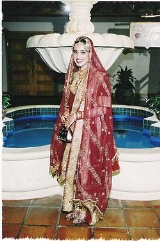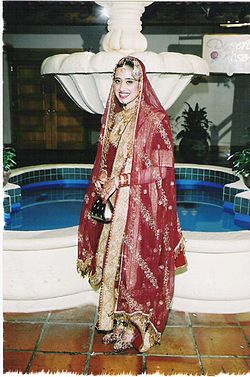
Khara Dupatta
Encyclopedia

Wedding dress
A wedding dress or wedding gown is the clothing worn by a bride during a wedding ceremony. Color, style and ceremonial importance of the gown can depend on the religion and culture of the wedding participants.- Western culture :...
of Hyderabadi Muslim brides. It is an elaborate wedding
Wedding
A wedding is the ceremony in which two people are united in marriage or a similar institution. Wedding traditions and customs vary greatly between cultures, ethnic groups, religions, countries, and social classes...
ensemble comprising a kurta
Kurta
A kurta is a traditional item of clothing worn in Afghanistan, Pakistan , Nepal, India, Bangladesh, and Sri Lanka. It is a loose shirt falling either just above or somewhere below the knees of the wearer, and is worn by both men and women...
(tunic), chooridaar (extra-long slim pants that gather at the ankles), and a 6-yard dupatta
Dupatta
Dupatta Dupatta(Urdu: دوپٹا, Hindi: दुपट्टा, Bengali: ওড়না, Sindhi: پوتي, Tamil:துப்பட்ட) Dupatta(Urdu: دوپٹا, Hindi: दुपट्टा, Bengali: ওড়না, Sindhi: پوتي, Tamil:துப்பட்ட) (alternative names include chadar (in Pakistan), orni/odhni, chunri, chunni, orna, and pacheri, is a long,...
(stole or veil
Veil
A veil is an article of clothing, worn almost exclusively by women, that is intended to cover some part of the head or face.One view is that as a religious item, it is intended to show honor to an object or space...
).
History
Early in the 17th century, TurkishTurkic peoples
The Turkic peoples are peoples residing in northern, central and western Asia, southern Siberia and northwestern China and parts of eastern Europe. They speak languages belonging to the Turkic language family. They share, to varying degrees, certain cultural traits and historical backgrounds...
and Persian craftsmen were invited to India
India
India , officially the Republic of India , is a country in South Asia. It is the seventh-largest country by geographical area, the second-most populous country with over 1.2 billion people, and the most populous democracy in the world...
by Mughal
Mughal Empire
The Mughal Empire , or Mogul Empire in traditional English usage, was an imperial power from the Indian Subcontinent. The Mughal emperors were descendants of the Timurids...
Empress Noor Jehan to craft a noble dress, that became particular only for family members of Mughal noble ladies . The art of dupatta crafting remain particular to Mughal descendants. Later when Mughal governer Nizam-ul-Mulk declared his autonomy over Hyderabad Deccan Suba, the begums of Nizam's family modified the creative style of Mughals to form Khara Dupatta. Which was later practiced by general residents of Hyderabad. The montage gallery at Chowmahalla Palace
Chowmahalla Palace
Chowmahalla Palace or Chowmahallat , was a palace belonging to the Nizams of Hyderabad state. It was the seat of the Asaf Jahi dynasty and was the official residence of the Nizam....
exhibits the life style royal dresses of Nizams Begums which includes Kara Dupatta.
The ensemble
Sometimes the kurta is worn with a long, lightweight sleeveless overcoat or a shorter koti, a bolero-like waistcoat. The brides wears a matching ghoonghatGhoonghat
Ghoonghat or Ghunghat is a Hindi word which describes a veil or headscarf worn by Indian women to cover their head, and often their face. Generally a pallu is pulled over the head to act as a ghunghat. A dupatta is sometimes used as a ghungat.-Description:The ghunghat varies in styles due to...
(veil) over the head.
The dupatta is usually made of net material and embroidered
Embroidery
Embroidery is the art or handicraft of decorating fabric or other materials with needle and thread or yarn. Embroidery may also incorporate other materials such as metal strips, pearls, beads, quills, and sequins....
with zardozi
Zardozi
Zardozi or Zar-douzi work is a type of embroidery in Iran, India and Pakistan.-Iran:Zardozi is on of the most important elements of Persian cultural signs and Handicrafts. It is named around the country by names such Zar-douzi , Kam-douzi , Gol-douzi and Kaman-douzi...
work. The border of the dupatta has masala or a ribbon border with embroidered golden motif
Motif (textile arts)
In the textile arts, a motif is a smaller element in a much larger work. In knitting and crochet, motifs are made one at a time and joined together to create larger works such as afghan blankets or shawls. A good example of a motif is the granny square.Motifs can be any size, but usually all...
s.
The usual accompanying jewellery is:
- Tika - a medallion of uncut diamonds worn on the forehead and suspended by a string of pearls
- Jhoomar - a fan shaped ornament worn on the side of the head
- Nath - a nose ring with a large ruby bead flanked by two pearls
- Chintaak aka Jadaoo lachcha or Guluband - a choker studded with uncut diamonds and precious stones
- Kan phool - earrings that match the Chintaak and consist of a flower motif covering the ear lobe and a bell shaped ornament that is suspended from the flower. The weight of precious stones and gold in the Karan phool is held up by sahare or supports made of strands of pearls that are fastened into the wearers hair.
- SatladaSatladaSatlada is a seven stringed pearl necklace typically made in Basra. It has 465 pearls embedded in it. It can also be set with emeralds, diamonds and rubies.Some of the pearls are so large they look like small eggs, or outsized peas....
- necklacke of seven strands of pearls set with emeralds, diamonds and rubies - Ranihaar - a long strand of pearls with a wide pendant
- JugniJugniJugni is an age-old narrative device used in Punjabi folk music and sung at Punjabi weddings in Pakistan, India, US, Canada, Australia and UK. The word literally means 'Female Firefly', in folk music it stands in for the poet-writer who uses Jugni as an innocent observer to make incisive, often...
- necklace with several strands of pearls with a central pendant - Gote - Shellac bangles studded with rhinestones and worn with gold colored glass bangles called sonabai
- Payal - anklets
- Gintiyan - toe rings
Wearing style
The dupatta is draped with the very top part of the middle of the dupatta tucked into the back of the chooridaar. The dupatta is folded accordion pleats at both ends, which are held in place on the left shoulder with a broochBrooch
A brooch ; also known in ancient times as a fibula; is a decorative jewelry item designed to be attached to garments. It is usually made of metal, often silver or gold but sometimes bronze or some other material...
. The free ends of the dupatta are worn under the right shoulder and over the inside of the right elbow.
External link
See also
- AchkanAchkanAchkan is a long jacket worn in South Asia, and together with the Sherwani, is traditionally associated with the Northern Indian aristocracy.-History:...
- Indian wedding clothesIndian wedding clothesIndian wedding clothes is the set of clothes worn by the bride, bridegroom and other relatives attending the wedding during a marriage.-Clothing culture:...
- GhoonghatGhoonghatGhoonghat or Ghunghat is a Hindi word which describes a veil or headscarf worn by Indian women to cover their head, and often their face. Generally a pallu is pulled over the head to act as a ghunghat. A dupatta is sometimes used as a ghungat.-Description:The ghunghat varies in styles due to...
- Indian dressIndian DressThe traditional clothing in India varies with region, religion and community. The formal business attire is fairly uniform across the country, and similar to the western clothing.- Women's Clothing :...
- Salwar kameez
- ChuridarChuridarChuridars , or more properly churidar pyjamas , are tightly fitting trousers worn by both men and women in South Asia and Central Asia. Churidars are a variant of the common salwar pants. Salwars are cut wide at the top and narrow at the ankle. Churidars narrow more quickly, so that contours of the...
- KurtaKurtaA kurta is a traditional item of clothing worn in Afghanistan, Pakistan , Nepal, India, Bangladesh, and Sri Lanka. It is a loose shirt falling either just above or somewhere below the knees of the wearer, and is worn by both men and women...
- Ghagra
- Lehenga
- DupattaDupattaDupatta Dupatta(Urdu: دوپٹا, Hindi: दुपट्टा, Bengali: ওড়না, Sindhi: پوتي, Tamil:துப்பட்ட) Dupatta(Urdu: دوپٹا, Hindi: दुपट्टा, Bengali: ওড়না, Sindhi: پوتي, Tamil:துப்பட்ட) (alternative names include chadar (in Pakistan), orni/odhni, chunri, chunni, orna, and pacheri, is a long,...
- Wedding sariWedding sariA wedding sari is the traditional wedding dress of Indian women. The sari is traditionally red, with golden embroidery. In Kerala the saris are traditionally white/cream with gold embroidery....

